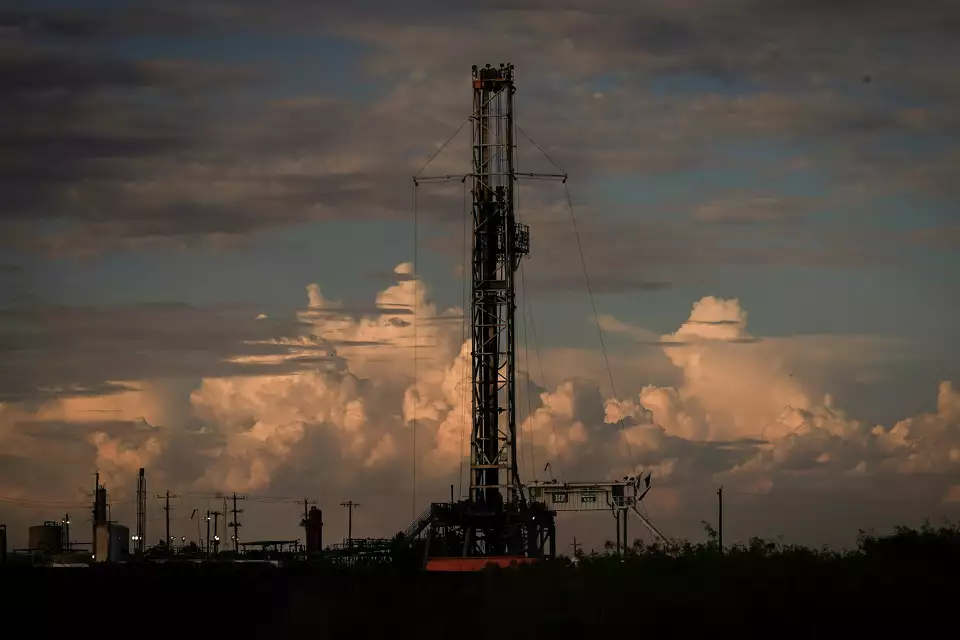Fracking, short for hydraulic fracturing, is injecting a liquid at high pressure to fracture and force open fissures in rock formations to extract oil or gas. Fracking is done in over 30 U.S. states but is more widespread in Texas, North Dakota, and Pennsylvania. As of 2024, only 5 states have banned fracking entirely. They are Vermont, New York, Maryland, Washington, and California. But in Kentucky specifically, it’s regulated, like everywhere that allows it. However, just because regulations are in place doesn’t mean oil and gas industries can’t find loopholes to exploit our communities. Their risk-taking with fracking could be dangerous. But what is the danger?
For starters, fracking emits greenhouse gasses, lots of wastewater, toxic air pollutants, and lots of noise. While some of it sounds tame, it’s far from it. Greenhouse gases get trapped in the atmosphere, preventing them from escaping back into space. Then, this absorbs radiation from the sun and warms the planet’s surface. This is why it’s so hot nowadays. One of the most potent greenhouse gases is methane. Methane can have several effects on our health and environment, like the one listed above, though one can be particularly shocking. And that’s bubbly flammable water. This is because of blowouts while fracking. Blowouts are when the gas fracking extracts start uncontrollably ejecting from the wellhead due to either a malfunction or human error. The blowout sends wastewater into the environment into both above ground and below ground water. This contaminates the water supplies of people close to fracking operations. While this is a bit of a rarity among those close to fracking operations, it can still happen and is dangerous. The impact can vary based on frequency and severity.
Anyways, the medley of chemicals and junk in wastewater is things like salt, oil, grease, metals, radioactive materials, and manmade fracking chemicals, which is what makes the wastewater so dangerous. So people face not having clean drinking water, but there are even more dangers about fracking itself. The danger for humans, specifically those who are close to these fracking operations is increased adverse pregnancy outcomes, cancer incidence, and hospitalizations. With adverse pregnancy outcomes, it’s been observed that pregnant women living within 6 or so miles of a fracking operation experienced more spontaneous births and had children with smaller gestational ages. The risk of getting leukemia or lymphoma also increases, though other cancers can appear, since the chemicals that fracking releases are cancerous. The reason for hospitalizations is similar, an association found that the chemicals people have been exposed to through either the air or water have increased rates of hospitalization for heart diseases like acute myocardial infarction, heart failure, and ischemic heart disease.
But these blowouts along with fracking are not only incredibly harmful to people, but also the environment. When fracking, each well needs millions of gallons of water, which robs wildlife of their only source. And along with taking their water, they give it back riddled with chemicals that make it undrinkable. Fracking can also lead to loss of animal and plant habitats, species decline, migratory disruptions, and land degradation. This is because they have to take land to drill, and the process of it destroys the land.
While these companies aren’t entirely at fault, how would they have known the dangers? They’re still responsible for cutting corners and inefficiently following regulations. An example of where this can be seen is in Estill County, Kentucky. It’s a town brimming with churches and farms crowded about and cozied up with a beautiful national forest, the Daniel Boone National Forest, which is all just south of us. In this peaceful county is an unassuming town called Irvine, with a simple population of just 2,400. But the issue within that county was a landfill riddled with 1,900 tons of radioactive, and possibly carcinogenic, waste right across the streets from a school. After the company Advanced Disposal bought farmland, residents of the town had to bear witness to the Blue Ridge Landfill slowly being built. Its construction finished in 1984. Then in 1995, a legally binding Host Community Agreement was made. Since Blue Ridge Landfill was a solid waste facility, they couldn’t take ash residue from either a nearby gas nerve and blister gas story facility or radiological waste from anywhere else. But not soon after, only in a mere couple of years, Blue Ridge began to threaten to undercut the agreement and profit from accepting 90,000 tons of soil and pipes with naturally occurring radioactive materials. The community then filed a lawsuit and protested against them to keep waste out of Irvine in 1997, which worked. Blue Ridge withdrew its state permit to accept radioactive waste and the county dropped the lawsuit, all by the end of summer.
This victory was diminished though after the landfill began to accept waste 20 years later. It was the leftovers of fracking sent from Ohio and Virginia, it crossed state lines just to dump them in a small town. It was almost all sent by a West Virginia water recycling company called Fairmont Brine Processing, LLC. They recycle wastewater from fracking, which is the most environmentally responsible way to handle wastewater, the issue is that the impurities become a concentrated solid known as TENORM. The acronym stands for Technologically Enhanced Naturally Occurring Radioactive Material, TENORM. Virginia began to require radiation monitors for all solid waste landfills. This law made it harder for them to sneak any waste above the radiation limit where landfills weren’t equipped to handle it. Anyways, landfill and landfill brokers send proposals to recycling facilities, and in the case of Fairmont, they won the bid. This meant Hoskins brokered a deal for Blue Ridge to take their waste, despite it being illegal. It ended with Hoskins being fined $5.3 million and Advanced Disposal (the company that owns Blue Ridge) paying a $95,000 civil penalty.
Blue Ridge continued to accept radioactive waste. This time it was through filter socks, something that filters through waste and catches all radioactive waste. It’s used over and over, which results in an incredibly high concentrated radioactive level. They always exceed the limit of acceptable radioactivity. And in Blue Ridge, where they’re not supposed to accept any waste whatsoever, accepted up to 62 trucks full of it. In papers where it asks if the necessary state approvals have been granted, the response was simply “N/A”.
Radioactive waste can also be conveniently misplaced or forgotten about in transit. This is referred to as orphan waste. It happens since federal law doesn’t require fracking waste to be monitored the entire time it takes to dispose. It’s a frequent occurrence since the oil and gas industry produces so much waste with no place to put it. In 2012, fracking nationwide produced up to 280 billion gallons of wastewater. And with no one to be sure it’s properly disposed of, it can become orphan waste. It becomes an even bigger issue when it comes to the rules for disposing of oil and gas waste from state to state. The federal government regulates hazardous waste under the Resource Conservation and Recovery Act. However, industries are taking advantage of the loopholes that exempt billions of barrels of waste that are produced. Under the regulations, fracking leftovers, even radioactive kinds, fall into the non-hazardous category. While the U.S Environmental Protection Agency (EPA) has minimum standards for oil and gas waste disposal, it’s up to the states to conduct enforcement and permitting. When EPA passed RCRA in 1988, the agency had promised to update waste disposal guidelines, but 3 decades have passed and nothing has changed. So, environmentalist groups, one notable one being the Environmental Integrity Project, sued EPA in 2015. It resulted in a settlement requiring the EPA to decide to strengthen its guidelines by March 2019, which they did.
But back to Estill, the residents have been presented with a decision by Blue Ridge. In 2015, Blue Ridge submitted a corrective plan to Kentucky’s EEC for dealing with the waste they brought in. To either cap it into the ground or to remove it. EEC chose to cap it. Leaving the radioactive waste where it lies is the best decision for a short-term solution. This means the environment and people would be safe. Though there have been disagreements, the Kentucky Environmental Foundation program director, Craig Williams, has said that none of the investigations into Estill’s waste tested it. They looked at samples at Fairmont, which were only looked at months later. However, there are also other concerns, like the leachate, water that moves through the layers of landfill. But, a water treatment plant in Irvine treats the water before it gets released into the Kentucky River. If such a thing did, Blue Ridge Landfill described a worst-case scenario when capping the waste. Radiation would be so bad it’d contaminate groundwater for the next 2,700 years. While it’s still being treated, that doesn’t mean it’s a guarantee something can’t happen. If there’s just a small enough mistake to pass by or not enough protection (i.e. lining) the radioactive material could mix into the groundwater or intertwine with local streams. However, the creeks and rivers that travel through the leachate are another worry. They either go into the river, which is bad since 42 counties pull 100 million gallons of water from there, or they drain into other rivers, like the Ohio River. This would mean harm to all of central Kentucky.
But the second option isn’t that good either. There’s a risk that digging up the waste would require exposing workers to its radiation during removal. That also means kicking up a ton of dust that could be dangerous. This would be a very lengthy process as well, as where they’d have to excavate is a 7-acre landfill, and not all of it is radiation. It’s unclear as to where all the radiation is, even then you’d still be unsure whether you got every little bit. Not to mention, the removal plan would require nearly 1,900 truckloads of waste to be transferred. That would take roughly 3 months to complete, which means more noise and risk for accidents. And while these risks are overblown, there’s still danger in these plans, no matter the precaution.
The cost is another issue, digging it up and removing it would be more expensive than capping it, and the price is estimated to be more than $6 million dollars. Capping it, on the other hand, would only be just under $300,00.
After months of public hearings and comments, the residents of Estill County filed a petition in June for the state to reconsider its acceptance of Blue Ridge’s proposal to cap the waste. Their concerns were that the county is already struggling economically, they fear that trying to attract businesses and increase land prices would be nearly impossible if the waste was capped. But, a decision has been made already. The citizens chose to cap the waste, as they thought it was the safer option. The landfill agreed to provide funding that the community can use to monitor and maintain the landfill site after the landfill’s permit expires. That money, combined with the capping and monitoring, is Estill’s reassurance that the community will be protected.
This news finally wrapped up in 2019, which is admittedly late news, but the issue at hand is that companies put people in danger simply because they wanted to be rid of their waste by dismissing regulations and laws. While it’s been remedied, not everyone can do what Estill did, or come out as safely. Even then there can still be disastrous effects. Other places can suffer the same fate and be powerless to do anything against it.













